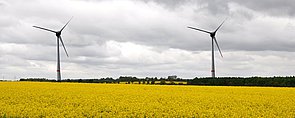Visual Landscape Analysis and Visualization
OECOS GmbH has acquired various assessments and statements concerning the possible impairments of the landscape by onshore wind turbines. The aim was to examine and evaluate the compatibility of planned wind energy plants with the interests of landscape and monument protection. The photographic visualization of the planned wind turbines illustrated the main basis. We prefer photography as a as proved successful method over filmic visualization due to the thereby more conscious awareness and observation of the landscape. In addition, the photographic observation helps to see the landscape in perspective. To determine the possible adverse effects on the landscape, OECOS GmbH created photorealistic visualizations of planned offshore wind farms in the Baltic Sea. These visualizations were based on trigonometric calculations considering earth’s curvature and refraction. It is increasingly important to include existing or already approved wind farms in the visual environment cumulatively.
The method of visualization is currently being unified by the BSH in the StUK 4 with the critical cooperation of our team:
- Presentation showing a normal point of view (no telephoto lens POV) at a horizontal angle of 52°–54°.
- Contrast presentation of full rotor blade width at optimal visibility conditions.
- Visualization with 2 m scale bar (7 m distance from the observer) to demonstrate size relations. Other items, such as persons in the foreground, help to provide an additional scale.
- The presentation must provide the visualization parameters and the scale-dependent observation distance (normal perspective: DIN A3 approx. 43 cm, DIN A4 approx. 30 cm).
- Presentation of an outline map indicating horizontal and vertical angles of vision at which the wind farm will be visible from selected vantage points.
- The wind farm must be visualized individually as well as cumulatively with potentially adjacent approved or firmly planned wind farms. The visualizations should allow for assessing the changes to the landscape between the approved status quo or the planned status quo and the planned completed state.


